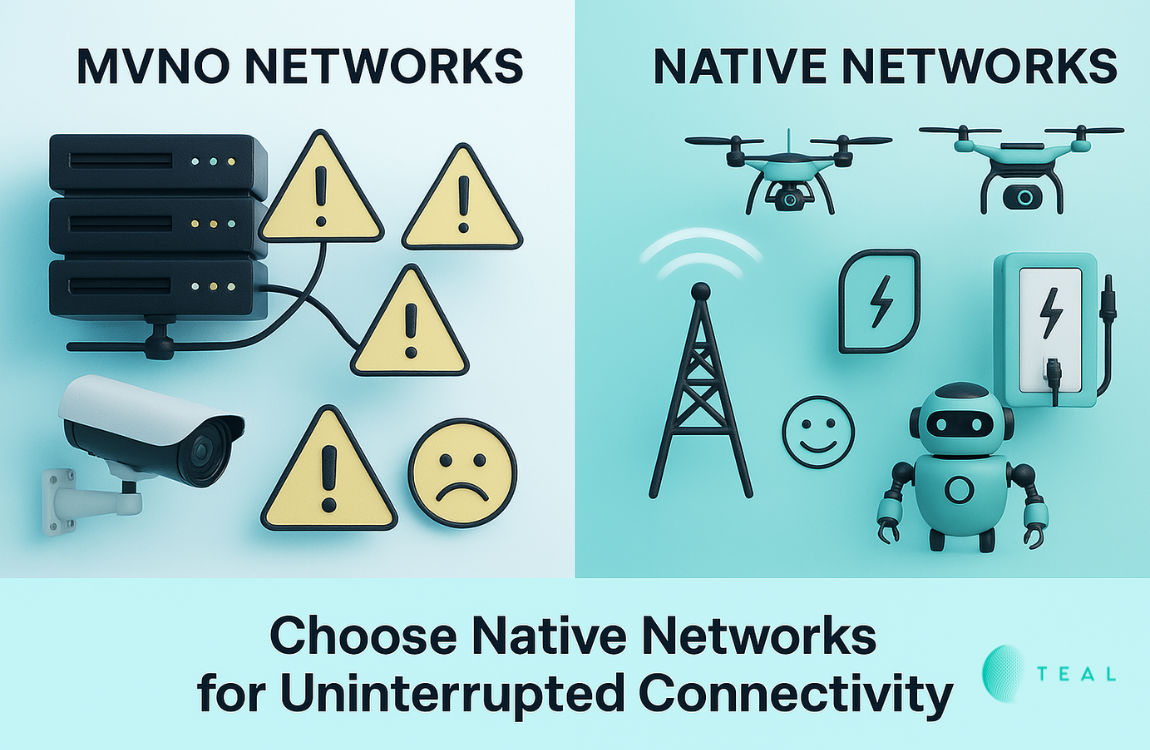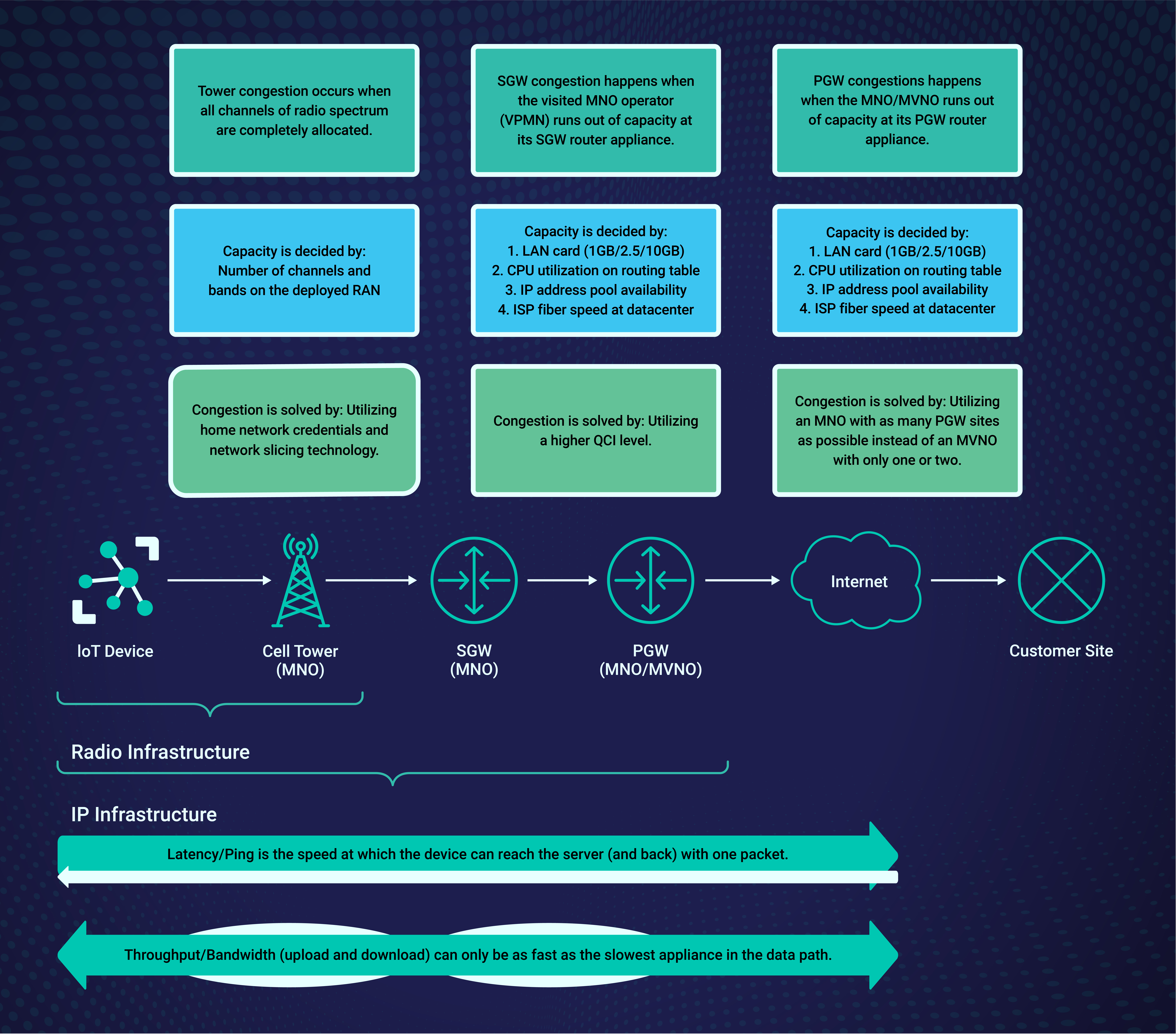Native vs MVNO Networks: Why Native Networks Are the Smarter Choice for Avoiding Cellular Network Congestion

Cellular network congestion is more than just an inconvenience—it can disrupt communication, hinder operational efficiency, and cause major headaches for businesses and individuals relying on seamless connectivity. While Mobile Virtual Network Operators (MVNOs) appear to be an attractive option due to their often lower costs, they can’t stand up to Native Mobile Network Operators (MNOs) when it comes to avoiding network congestion.
If you prioritize reliable, uninterrupted connectivity, here’s why native network connectivity should always be your top choice. This analysis is backed by the technical insights that explain why.

What Causes Network Congestion?
Before understanding why native networks outperform MVNOs, it’s important to know how network congestion happens. Here are three main areas we will explore in further detail:
Tower Congestion
This occurs when all channels of the allocated radio spectrum are fully used, leaving no capacity for new connections. The capacity of a tower’s Radio Access Network (RAN) is determined by the number of available channels and bands.
SGW (Serving Gateway) Congestion
The SGW acts as a mobile network’s traffic controller, managing data routing between the user device and the internet. Congestion arises when the operator’s SGW router capacity is maxed out. Limited LAN card speeds, high CPU utilization, insufficient IP address availability, or slow ISP fiber can all contribute to this bottleneck.
PGW (Packet Data Network Gateway) Congestion
The PGW handles data transfer between mobile networks and external networks like the internet. MVNOs and some MNOs can run into congestion at this gateway when capacity is stretched, caused by limited LAN speeds, overburdened CPUs, or too few datacenter sites.
Now that we’ve outlined the challenges, here’s why native networks are equipped to solve them—and why MVNOs often fall short.
Why Native Networks Outperform MVNOs During Congestion
Native networks dominate MVNOs in their ability to consistently deliver reliable connectivity, particularly during heavy congestion. Here’s why:
- Larger PGW Deployments
Native MNOs typically have multiple PGW sites distributed across their home country. The result? Greater data capacity and reduced chances of localized congestion. MVNOs, by contrast, tend to maintain a limited number of PGW sites to minimize costs, making them more susceptible to capacity overload.
- Higher QCI Prioritization for Traffic
Native networks enjoy the highest priority quality levels on the Serving Gateway (SGW) thanks to their QCI (Quality of Service Class Identifier) allocation. QCI is a technical mechanism used by mobile networks to prioritize different types of data traffic. Native MNO customers receive preferred treatment in terms of data allocation and performance, reducing latency and ensuring stable connections even during peak usage times. MVNOs, on the other hand, often lack QCI prioritization altogether.
- Tower Prioritization Based on IMSI Prefix
A user’s connection priority is influenced by their IMSI (International Mobile Subscriber Identity), a unique identifier assigned by their network. Native MNO subscribers are prioritized at the tower level due to their IMSI prefix. MVNOs, using internationally sourced numbers, often receive lower prioritization, meaning slower or less reliable connectivity, particularly during peak congestion.
These advantages make native networks unbeatable for enterprises and individuals alike when uptime and performance matter most.
Why MVNOs Fall Short Under Network Strain
While MVNOs may appear cost-effective on paper, their limitations become glaringly obvious in real-world scenarios of network congestion. Here are some drawbacks:
- Lower Prioritization on Native Towers
MVNO connections often function as “secondary users,” resulting in delayed or dropped connections during periods of high usage.
- Limited Resource Allocation
MVNO PGWs typically have lower capacity and fewer sites compared to MNOs, translating to reduced reliability and increased chances of bottlenecks.
- No QCI Prioritization
Without respected QCI priority, MVNO subscribers may experience inconsistent data speeds and degraded service quality.
These constraints make MVNOs an unsuitable choice for businesses or users who cannot afford disruptions to their connectivity.
Addressing Congestion with Native Networks
The superior performance of native networks in congestion scenarios comes down to the following technical factors:
Tower Congestion
How native networks solve tower congestion:
- Capacity upgrades through investment in additional spectrum channels and bands.
- Network slicing technology to allocate private, high-quality network segments for critical users.
SGW Congestion
How SGW congestion is prevented:
- Use of advanced hardware including high-speed LAN cards and optimized CPU capacities.
- Enhanced IP address allocation and partnerships with ISPs offering robust fiber networks.
- Deployment of native SGWs with prioritized QCI levels on all routing tables.
PGW Congestion
How native networks prevent PGW congestion:
- Offering multiple datacenters to minimize traffic overload at any single site.
- Utilizing high-performance LAN cards and distribution of routing loads across optimized CPUs.
- Providing ample IP pools and rapid fiber speeds at data transfer hubs.
These measures ensure that native networks handle congestion with ease, keeping users connected no matter the demand on the system.
Why Choose TEAL for Unmatched Connectivity?
When it comes to leveraging native networks globally, TEAL’s connectivity solutions lead the industry with innovative technology and unmatched coverage. Here’s how TEAL stands out:
- Unparalleled Network Access
TEAL’s platform provides native connectivity directly to the largest tier-1 networks including AT&T, Verizon, T-Mobile, Rogers, Three Group Solutions, MTN, while offering native coverage on networks in 196 countries worldwide. Wherever your devices operate, TEAL ensures optimal native connectivity.
- Seamless Over-the-Air Flexibility
Unlike traditional SIM cards, TEAL allows you to switch carriers over-the-air, ensuring access to the strongest network available without swapping physical SIMs.
- Reliable, Future-Proof Solutions
With advanced network slicing, native prioritization, and robust infrastructure, TEAL eliminates risks like roaming restrictions or infrastructure sunsets, adapting to the demands of tomorrow’s IoT applications.
- Tailored for Your Needs
Our flexible solutions are designed for organizations of every size—from small startups to large enterprises—all at affordable pricing.
Whether you’re managing IoT deployments, surveillance systems, or autonomous devices, TEAL’s native network capabilities deliver the confidence you need to keep your operations running smoothly.
Stop relying on subpar MVNO solutions. Upgrade to a reliable, future-proof connectivity platform with TEAL today.
Click the link below to schedule a free consultation with a TEAL expert and discover the power of native network access for yourself!
Book a Meeting Now!
Recent Posts
Innovations in Motion: Exclusive Interviews from MOVE America in Detroit
Teal Communications Staff2025-10-16T17:07:05+00:00
Why Physical AI Systems Fail Without Reliable Connectivity
Teal Communications Staff2025-10-07T23:19:27+00:00
See the Future of Connectivity at MWC Las Vegas
Teal Communications Staff2025-09-30T14:19:04+00:00




